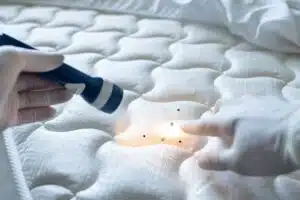Cockroaches are known for a few things among those who have dealt with them, and one especially common part of their reputation is just how quickly they reproduce. This is part of what makes cockroaches such a pain to deal with if they infest structures — between this and the fact that they’re tough to kill off with just home remedies, it’s no wonder cockroaches are some of the most well-known pests.
At A-1 Exterminators, we’re here to help with a wide range of commercial and residential pest control services in West Jordan and nearby areas, including any insects that are causing problems in your home or building. For some, it helps to understand a bit more about exactly how the cockroach life cycle works — here’s a basic primer on how they mate, lay eggs, mature and eventually live out their life cycle.
Mating and Egg Creation
One of the first unique things about cockroaches is the way they mate, which is unusual even for insects of their type. Male cockroaches will “show off” to the female, almost like a peacock in some ways, by waving their antennae and legs in certain patterns while also flapping their wings and exposing their abdomen. In some cases, they will even nibble at the female. If the female is receptive, she’ll allow him to climb on top of her back and mate; if not, she may fight him off or try to run away.
Once they’re done mating, the female cockroach will find a hiding place away from any potential predators or other dangers to lay her eggs. She’ll create a small opening in whatever surface she’s chosen and deposit her eggs inside, then seal the opening back up to protect them. Cockroach egg cases can have anywhere from around 10 to 50 individual eggs depending on the species of cockroach; here are some specific species and the amounts of eggs often laid:
- German cockroaches: These typically lay 20-40 eggs at a time, and have an incubation period of 28 days. Female German cockroaches can usually lay four or five cases of eggs in their lifetime, though some have been known to lay up to eight.
- American cockroaches: These typically lay 16-24 eggs at a time, and have an incubation period of 42-44 days. Female American cockroaches can lay around 150 total eggs in their lifetime.
- Brown-banded cockroaches: These typically lay 10-18 eggs at a time, with around 16 being the most common number. They have an incubation period of anywhere between 37 to 103 days, largely depending on the temperature and environment they’re in.
- Oriental cockroaches: These also lay about 16 eggs at a time, but with an incubation period typically right around 60 days. They can lay about eight oothecae (egg cases) in their lives, or just over 125 eggs in a full lifetime.
As you can see just from a glance at these common cockroach types, they all lay a huge number of eggs over the course of their lives — and those are just averages. Some individual cockroaches have been known to lay even more eggs than what’s listed here.
Hatching and Maturation
Once the eggs have been laid, it’s only a matter of time before they hatch and the nymphs (baby cockroaches) start to emerge. In most cases, it takes around two weeks for the eggs to hatch, but this can be shorter or longer depending on the temperature and other environmental factors.
Once they’ve hatched, the nymphs will look a lot like adult cockroaches — just smaller, of course. They’ll also lack wings at first, though they’ll develop these as they mature. The nymphs will go through a series of molts (shedding their outer shell) as they grow, and each molt will see them becoming larger and more like an adult. Depending on the species, it can take anywhere from two months to over a year for a nymph to reach full adulthood.
In fact, some species (the American cockroach, in particular) will molt up to 10 different times before they’re fully mature. Once they’ve reached this point, they’ll be able to mate and start the cycle anew.
The Length of a Cockroach’s Life
Now that you know how cockroaches reproduce, you might be wondering about how long they live. Unfortunately for anyone dealing with an infestation, cockroaches can live for quite a period compared to most insects, though again this depends on the species in question and other environmental factors.
The German cockroach, for example, has an average lifespan of around 200 days — for both males and females. Brown-banded cockroaches have a similar lifespan, and Oriental cockroaches are typically a bit less — 160 days for males, 180 days for females. Once again, the American cockroach is the most resilient here: Males can live for around a year, while females often live for just shy of two full years.
For those who have had cockroach issues in the past (or are dealing with them now), these lifespan averages might seem a bit low. After all, two years is a long time to deal with any sort of infestation — let alone one as difficult to get rid of as cockroaches. However, it’s important to remember that these are just averages; some cockroaches have been known to live for much longer.
Luckily, pest control professionals like ours at A-1 Exterminators have all the tools needed to help you deal with any kind of insect issue you’re dealing with, including cockroaches. For more on this topic or any of our pest control services in West Jordan or nearby areas, speak to our team today.



